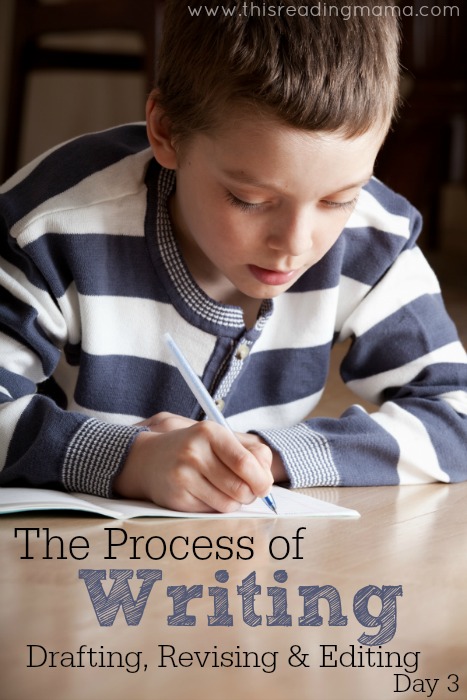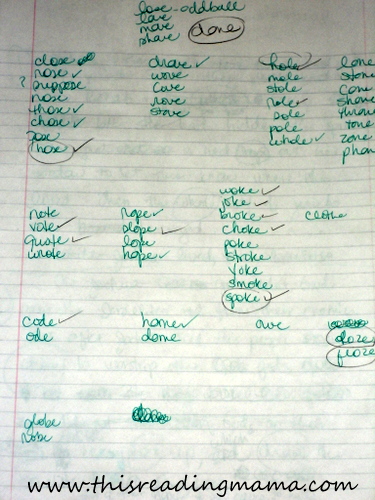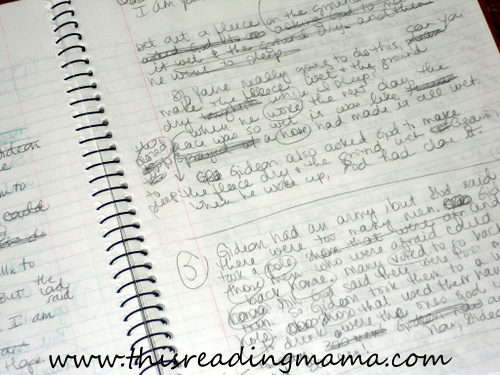Welcome to This Reading Mama. I’m in the very middle of a 5-day series I’m calling Unleashing the WRITER in your Child. My focus is not so much giving you hands-on activities that you can print off and use, but challenging your mindset towards writing as you teach it to your own kids (at home or at school). The ideas I’ve been sharing are based off of the Writer’s Workshop approach, but I’m modifying them a bit for the homeschool setting. To see the introduction to this series or any of the topics covered so far, click on the image above or HERE.
*This post contains affiliate links. To read more about this, please see my disclosure policy.
Organizing Thoughts Before Writing
Once a writer has a “seed” (see yesterday’s post on choosing a topic), he is ready to start drafting. In the classroom, my students had writing folders, like these, in which they kept blank paper for writing time (also known as Writer’s Workshop). This was separate from the Writing Notebooks that I referred to yesterday. {At home, we don’t have an official writing folder, but we may very well start one as this series has inspired me to do better with this.}
Before writing a draft, it can be helpful to organize the ideas somehow. Kids may use a graphic organizer, like the one pictured on Day 1. They might also start with an outline or a list, as I do for each of my Phonics by The Book Bible stories:
But one thing is certain: each author is different. We can model different ways to organize writing thoughts, but demanding that they use one particular model over another is counterproductive. Let the child choose how he begins organizing his thoughts. If her system of organizing works for her, let her do it. And sometimes, the child may skip this step altogether and do just fine with the draft.
Writing a Draft
The main focus of writing a draft is getting those thoughts down on the paper. There may or may not be complete sentences. There may even be misspelled words (oh, the sin). I like to call this stage the “sloppy copy”. Take a look at the picture below of my sloppy copy of The God of Hope. S.L.O.P.P.Y.
When my son first starting drafting with me, he wanted his drafts to look neat, with no mistakes. The poor thing must have torn that thin writing paper 10 times. Then, I showed him my sloppy copy and said, “I don’t want to see any eraser marks on your paper. I only want to see scribbles.” Oh, the freedom there was in that statement! Neat and clean drafts are simply not a reality to most writers!
But, one thing is certain about writing: IT TAKES TIME! I love what Ray says in The Writing Workshop, “It takes time to become a ‘good’ writer. It’s okay if [kids] write a lot of not-so-good stuff. Professional writers say they spend lots of time ‘fooling around’ with writing before they get to the good stuff.” (pg. 8) I like to give my 1st grader at least 20 minutes of writing time a day. I try to keep the room as calm and as quiet as possible, even playing quiet music in the background. Sometimes, he takes his lap desk and goes off to his room to write. He may even grab a book and use it as a springboard. Just like kids need time to read, they need blocks of time to write. And knowing what to do during that time doesn’t come naturally. It has to be modeled.
Conferring with the Author
Along the way, our young writers may hit a few road blocks. Maybe they don’t quite know what they want to write next. What should they do? This is where a conference with the author comes in quite handy. The focus of these early conferences is content or meaning, not editing. Regie Routman suggests, “Focus first on quality content, and work on editing later. Correct mechanics and form don’t matter much if the writing is so dull that no one wants to read it.” (Writing Essentials, 226)
When this happens with my 1st grader, I first ask him to re-read what he has written so far (re-reading is an IMPORTANT and very useful skill for any author). Once he gets to the place where he is stuck, I will sometimes ask him questions to get him thinking. Open-ended questions work best to show the reader you care about him as a writer and his message. “What message did you want the reader to know next?” or “If you were this character, what would you do next?” or “What could you write here that would make the person reading your story want to read more?”
 {picture source}
{picture source}
Sometimes, questions only confuse him. In such cases, I give some suggestions for where he could go next with his writing (in terms of content). Then I ask him to brainstorm more possibilities with me. This what “real” authors do, too! Ultimately, I leave the choice with him, “You are the author and it’s your choice. Think through all the things we talked about and choose what you think is best for your piece.”
About 90% of the time, questions and brainstorming works. For the other 10%, I usually say something like, “Do you know what I do when I’m stuck and I just don’t have a clue what to do? I put the piece down and do something else for a while. And sometimes, when I’m least expecting it, the answer comes to me; and then I go back and start writing again.” This helps him to understand that doubt and confusion is a normal and healthy part of the writing process. Questions drive us to find the answer. They keep us coming back for more.
Revising and Editing
Once the draft is reaching its final stages, it’s time to focus more on revising and editing. There is a difference between revising and editing. Revising focuses more on the meaning of the text and should happen all along the process: Could I have used a different word here? Can I combine these two sentences into one? Should I leave out that entire paragraph? “Much of revision is getting as close as you can to your intended message.” (Writing Essentials, 157) Editing focuses more on conventions: Do I need a capital letter there? Should I have put a period here? There is a similarity between the two: both show that we care about our writing and we care about our reader.
 {photo source}
{photo source}
Developing the craft for revising takes lots of time and is not something that comes naturally for young children. Most young writers think that all they write is essential and good and it is very hard for them to think outside of themselves. The more we can model this in our own writing, the pickier they will get about their own writing.
Editing is something that the child can do, if he is taught and held accountable to it. My son in first grade is held accountable to these things: complete sentences (including a complete thought, capital letter at the beginning & punctuation at the end) and spelling word wall words and word study patterns correctly. You can download our FREE C.U.P.S. editing check list and see how we use it here.
“The best advice on having efficient editing conferences is to be relentless in refusing to do for students what they can do for themselves.” (Writing Essentials, pg. 234). Kids should be held accountable for what they do know. Once my son has checked for these things, I edit the rest for “free” and he’s ready to publish the piece, if he so chooses. {We’ll talk more about publishing tomorrow.}
One more quick note on revising and editing (and one that I have to remind myself of CONSTANTLY): “Writers of all ages can only focus on so much at a time. Show me a writer who concentrates equally on handwriting, spelling, topic, language, organization, and information and I will show you a confused writer.” (Graves, 241) Calkins suggests to look through the writing and pick only one or two things that seem to be the primary roadblocks and teach/model those. Again, our goal is to teach to the writer, not the writing.
Celebrate with the Writer
Above all else, it is important to encourage and celebrate with your writer.
 {photo source}
{photo source}
First, look at what he has done correctly. Celebrate that! Did he try something new (even with limited success)? Celebrate that! “Celebrate your [kid’s] risk-taking…What we choose to celebrate sends a message about what we value, and that must be more than correct form and conventions…” (Writing Essentials, 19) I know I learn best when I’m supported and encouraged. Kids are no different.
Tomorrow, we’ll talk more about publishing and sharing our writing with others. And stay tuned for Friday. I’ll be posting more ideas and websites to help unleash that WRITER in your home!
 Feel free to hop around and visit the other bloggers as they share their ideas during this 5-day iHomeschool Network Hopscotch!
Feel free to hop around and visit the other bloggers as they share their ideas during this 5-day iHomeschool Network Hopscotch!
~Becky



I love the question suggestions for conferring with the writer! Thanks for the tips!